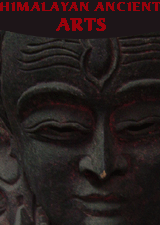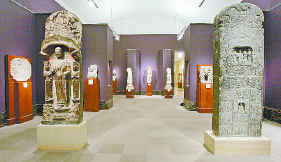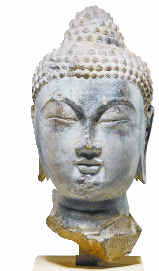Shop
By Type |
 |
|
|
|
|
|
|
|
|
|
|
|
|
|
|
|
|
|
|
|
|
|
|
|
|
|
|
|
|
|
|
|
|
|
|
|
|
|
|
|
|
|
|
|
|
|
|
|
|
|
|
|
|
|
|
|
|
|
|
|
|
 |
 |
Travel Packages  |
 |
 |
Newsletter |
 |
|
|
 |
|
 |
|
 |
|
 |
|
 |
|
 |
|
 |
|
 |
|
|
|
|
 |
Chinese Buddhist sculptures see new light: By ALICE THORSON, The Kansas City Star, Oct 25, 20044
Kansas City, Kansas (USA) -- Deep violet walls and a newly painted white barrel vault herald a dramatic reinstallation of the early Chinese Buddhist sculpture collection at the Nelson-Atkins Museum of Art.
|

|
?It's something I've wanted to do for 25 years,? said the museum's director and CEO, Marc Wilson, a specialist in Chinese art and mastermind of the reinstallation.
?You couldn't see anything before,? he said as he gazed around the newly renovated gallery. ?The room was dreary. (The sculptures) were lined up like bowling pins.
?It's the best collection in the country but (had) the worst display.?
|
With all the construction and renovation going on elsewhere on the museum campus, the Chinese galleries were not budgeted for a big fix. But the idea that the museum's world-renowned Chinese collection would not look its best for the 2007 opening of the new Bloch Building moved Wilson to action.
His mission is to spruce things up at minimal cost. For the Chinese sculpture he recycled carpeting and light fixtures from the old loan galleries downstairs. He removed the wall sconces but retained the existing wood pedestals.
Wilson designed the new stepped interior walls that create nichelike settings for the objects, a vast improvement over the ?bowling pin? setup. Thin marble strips cap the new walls, echoing the newly polished marble of the gallery baseboards. The trim strips came from old marble pillars that were ?salvaged and sliced,? Wilson said.
Most of the more than 60 Chinese Buddhist sculptures on view in the refurbished gallery were displayed there before. He added five pieces from storage and several previously displayed in other Chinese galleries and the hallway.
Wilson wanted to make the collection more accessible and understandable to visitors and encourage them to have ?dialogues? with individual pieces. The large works are displayed without vitrines, although smaller pieces, including more than a dozen gilt bronze sculptures, do appear behind glass.
About half of these small bronzes were given to the Nelson by its second director, Laurence Sickman, the museum's first curator of Oriental art and the man responsible for securing many of its Chinese treasures.
One of the most striking changes in the gallery is the lighting.
?I wanted soft light,? Wilson said. ?I didn't want to blow the form away and lose the nuance of surface.?
The one dissonant note in this inviting new scheme is the fluorescent bar illuminating the early sixth-century relief ?Procession of the Empress as Donor with Her Court? on the gallery's far west wall.
Mounted along the side of this 6-by-9-foot work,the fixture contributes a daylight effect, evoking the way the dark gray limestone slab might have appeared in the Binyang Caves at Longmen.
Yet in this context the white light seems harsh, and it doesn't help that the fluorescent tube is visible from some vantage points. But the problem will be fixed, Wilson said.
The works in the gallery range from the fifth to the 10th centuries, when Buddhism, which originated in India, became deeply ensconced in Chinese society and had a dramatic impact on Chinese art.
For one thing, it encouraged the creation of large-scale, permanent effigies of its deities in a country where sculpture had not been a major art form. For another, these were deities ?you could really talk to,? as Wilson points out, in the struggle to attain release from the cycle of suffering, death and rebirth, which is Buddhism's primary focus.
|

| Chinese artists responded to Buddhist ideas by gradually exchanging their centuries-old, flat, linear style for a rounder, fleshier, more naturalistic mode. The influence of Indian art also factors in here, as seen in the heightened sensuality of the later figures with their exposed upper torsos, rounded bellies and body-hugging robes. As time passed, the jewelry and ornaments adorning the deities became more sumptuous, a clue to the increasing wealth and sophistication of Chinese society.
The reinstallation presents objects chronologically, which illustrates the shift from a more linear style. But the scheme does not always hold. For starters, Wilson plucked two mid-sixth-century guardian figures out of chronological sequence to create a ceremonial entrance at the gallery's east end, where most of the seventh- and eighth-century works are grouped.
The big sixth-century Empress relief, though, which falls later than many of the objects around it, had to stay where it was.
It was simply too large and too heavy to move.
|
When the museum acquired it in the 1930s, it was in hundreds of pieces and took two years to reconstruct.
For chronology's sake, Wilson moved the two big limestone stelae, or tablets, that appear in the center of the reinstallation, after reinforcing the floor with a big steel beam.
One of them, ?Stele of Shakyamuni Buddha,? retains traces of paint, clearly visible under the new lighting.
All of these Buddhist sculptures, Wilson said, originally were painted. ?The bodies were gold. Light is synonymous with knowledge and wisdom.?
Wilson's reinstallation is the first update of this collection since it was put on view in 1941. Although the new display has been open since Oct. 2, it remains a work in progress as far as the interpretative materials go.
Nonspecialists can expect a lot more help in appreciating and understanding this gallery after the first of the year, when its violet walls will feature new labels and other didactic materials.
------------------------------------
Sculptures
? THE SHOW: ?The Glory of the Law: Treasures of Early Chinese Buddhist Sculpture,? a permanent collection reinstallation
? WHERE: Gallery 204, Nelson-Atkins Museum of Art, 4525 Oak St.
? WHEN: 10 a.m. to 4 p.m. Tuesday-Thursday, 10 a.m. to 9 p.m. Friday, 10 a.m. to 5 p.m. Saturday, noon to 5 p.m. Sunday. Closed Mondays.
? HOW MUCH: Free with regular museum admission.
? FOR MORE INFORMATION: (816) 751-1278
|
| |
| |
| |
| |
| ............................................................................................................................................................................................................................ |
|
 |
| |
 |
| |
 |
| |
 |
|
 |
| |
|
|
| |
| |
|
|
 My
Shopping Basket My
Shopping Basket |
 |
| |
 Best
Seller Best
Seller |
 |
 |
 |
|
Grape Pashmina Shawl |
| Price: US$
71.43 |
|
|
|
| |
 Start
with your budget Start
with your budget |
 |
|
|
| |
 Tell
a friend Tell
a friend |
 |
Tell a friend and win exciting gifts...
Click here
to learn more. |
 |
 |
 |
 |
 |
 |
 |
| |
 |
|